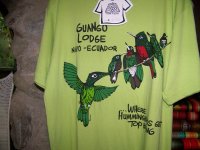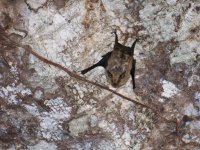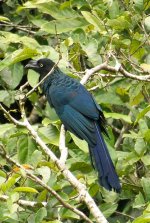4 and 5 Jan - Copalinga and Podocarpus
Our first full day at Copalinga was low-key, since Tom and I were both tired. Of course I spent some of the morning exploring the trails, but in the afternoon Tom and I wandered around Zamora, searching for beer among other things, and took a nap together in the hammocks on our porch. We were the only guests at Copalinga, so it was very peaceful, with only the sound of the river at night. The owners of the lodge, Catherine and Baldwin, were friendly and usually came to join us for meals. In fact, both nights they invited us into their home for dinner. It was a very pleasant stay.
In my casual wanderings of the reserve trails above the cabins, I encountered quite a few Swainson's Thrushes, fun to see this familiar face in such an exotic location. A real surprise was a large tinamou that ambled out into the trail ahead of me, grayish with a white stripe on the neck- a Gray Tinamou. Large tanager flocks roamed the forest edge near the cabins, many of which were familiar from my time at Tiputini, others new: Spotted, Blue-necked, Bay-headed, Blue-gray, Green-and-gold, and Paradise Tanagers were just a few. One of the few distinctive species of Elaenia, a Mottle-backed Elaenia sat up on one of the garden shrubs. The hummingbird feeders were dominated by Sparkling Violetear, but a few other species came by now and then: Violet-fronted and Purple-crowned Brilliants, Glittering-throated Emerald, and Fork-tailed Woodnymph. Away from the feeders, among the verbenas, was a spectacular, tiny male Spangled Coquette.
On the morning of the 6th Catherine dropped Tom and I off near the entrance to Podocarpus National Park. We hiked the trails for a few hours, and bird-wise it was fairly quiet. One notable exception was a Short-tailed Antthrush that kept walking along the trail ahead of us. Something seemed to be wrong with it, it was missing many of its feathers from its head, in fact it took several long looks before I was sure of the species. A Highland Motmot was another welcome addition, and a few mixed-species flocks contained Wedge-billed Woodcreeper, Ornate Flycatcher, and a Canada Warbler among others. It began to rain in late morning, so we took shelter in a roofed-in picnic area by the ranger station and ate lunch. As the rain let up momentarily, a large flock of tanagers moved through the area, with Golden and Golden-eared Tanagers, Orange-eared Tanager, Yellow-throated Bush-Tanager, and Black-faced Dacnis. Eventually we called it a day, and walked back to the cabins to dry off.









